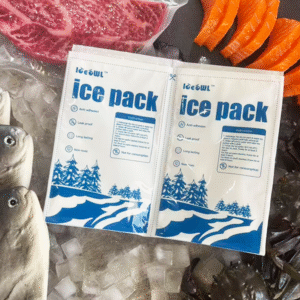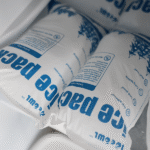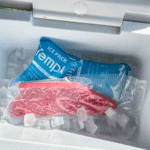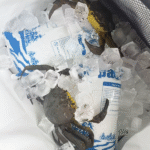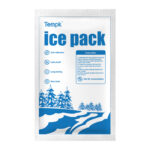Cara Mengemas Es Kering untuk Pengiriman Udara dengan Aman di 2025
Shipping dry ice by air requires careful planning and strict adherence to safety protocols. Improper packaging can lead to dangerous CO₂ buildup or shipment delays. Dalam panduan ini, you’ll learn how to package dry ice according to the 2025 peraturan, memastikan aman, patuh, and efficient shipments.
-
How to calculate dry ice quantity for air shipments.
-
What are the packaging materials and methods required?
-
How to label and mark your packages to comply with IATA rules.
-
Trends and innovations in dry ice shipping for 2025.
What is the Basic Requirement for Dry Ice Air Shipment?
Dry ice must be packaged in vented containers that allow CO₂ gas to escape. This is crucial to avoid pressure buildup which could cause explosions. Selain itu, the package must be labeled correctly with the proper shipping name (“Es kering” atau “Karbon dioksida, Padat”) dan PBB 1845 number. These requirements are part of the IATA’s Packing Instruction 954 (Pi 954), which remains the gold standard for dry ice air shipments in 2025.
What Packaging Materials and Methods Should You Use?
-
Isolasi: Use materials like EPS foam or vacuum-insulated panels (VIP) for optimal thermal insulation. VIPs are more efficient but costlier.
-
Ventilasi: Ensure that the outer container is not airtight. Use vent holes or leave flaps slightly open for proper gas release.
-
Strategi layering: Place dry ice around the product, separated by protective layers like cardboard or foam, ensuring that the dry ice doesn’t directly contact sensitive goods.
| Packing Element | Recommended Choice | Mengapa itu penting |
|---|---|---|
| Insulated Container | EPS foam or VIP | Ensures adequate insulation to control sublimation. |
| Kotak Luar | Corrugated cardboard, plastik | Provides structural strength and meets carrier needs. |
| Ventilasi | Built-in vent holes or tape gaps | Prevents dangerous CO₂ buildup from pressure. |
| Separation Material | Kardus, foam inserts | Prevents contact between dry ice and sensitive goods. |
Proses pengemasan langkah demi langkah
-
Pre-cool your products: Ensure your goods are pre-frozen to reduce thermal load.
-
Choose the right insulation: Select EPS foam or VIP for optimal dry ice retention.
-
Kemas es kering: Place the dry ice around but not in direct contact with the product.
-
Seal and vent the container: Leave small gaps or use vented flaps to allow CO₂ to escape.
-
Label correctly: Affix the Class 9 label bahaya, “Es kering” atau “karbon dioksida, Padat,"Dan 1845, and the net weight.
Key Regulations for Dry Ice Air Shipments in 2025
Marking and Labeling:
For all shipments, the following must be clearly visible:
-
Kelas 9 label bahaya
-
Dan 1845
-
Berat bersih es kering dalam kilogram (kg)
Deklarasi Shipper:
Dalam kebanyakan kasus, when shipping dry ice without other hazardous goods, a full Shipper’s Declaration is not required. Namun, for shipments containing dangerous goods (Dg), a full declaration is needed.
Carrier-Specific Rules:
Different airlines and carriers may impose additional limitations, such as maximum dry ice weight per package or specific requirements for container materials. Always verify with your carrier for route-specific rules.
How Much Dry Ice is Needed for Air Shipments?
To determine the correct quantity of dry ice, follow this formula:
-
Base Sublimation Rate: 5–10 lb per 24 jam, depending on insulation quality.
-
Penyangga: Always add 20-25% extra to cover unexpected delays or changes in route conditions.
Misalnya, for a 48-hour shipment, you would need approximately:
-
6 lb/day x 2 days = 12 lb
-
Menambahkan 25% buffer = 2.4 lb
-
Total dry ice required: 14.4 lb (~6.5 kg)
Special Considerations for Dry Ice Quantities
-
Passenger Shipments: Hanya 2.5 kg of dry ice per passenger is allowed (with carrier approval).
-
Cargo Shipments: The maximum dry ice allowed is 200 kg per paket, though airlines may set lower limits.
Dry Ice Air Shipment Documentation
When shipping dry ice, the following documentation is required:
-
Di waybill (AWB) dengan:
-
Dan 1845
-
Nama pengiriman yang tepat (“Es kering” atau “Karbon dioksida, Padat”)
-
Berat bersih of dry ice in kg
-
-
Daftar Periksa Penerimaan: Ikuti 2025 carrier dry-ice checklist to ensure all regulations are met.
What to Avoid When Packaging Dry Ice
-
Hindari wadah kedap udara: This can cause pressure to build up and lead to ruptures.
-
Don’t skimp on insulation: Insulasi yang buruk mempercepat sublimasi, increasing dry ice consumption and risks.
-
Ensure clear labeling: Incorrect or missing labels can cause delays or rejections.
-
Don’t ignore carrier-specific requirements: Each carrier might have additional rules—always check before shipping.
2025 Trends in Dry Ice Air Shipments
Sistem Pendinginan Hibrida:
Combining dry ice with phase change materials (PCMS) is emerging as a popular solution to reduce waste and ensure precise temperature control. This is particularly useful for shipments requiring temperatures that dry ice alone cannot maintain.
Kemasan Cerdas:
Smart sensors integrated into packages to monitor temperature and CO₂ levels are becoming more common, providing real-time data to optimize shipping processes and prevent issues before they occur.
Fokus Keberlanjutan:
As part of the growing trend for sustainable logistics, eco-friendly refrigerants like biodegradable gel packs and PCMs are being adopted as alternatives to dry ice in some air shipments.
Studi kasus: Biotech Shipment Success
A biotechnology company reduced spoilage by 25% and avoided regulatory violations by switching from traditional tight-sealing coolers to vented packaging kits. This change led to fewer shipment holds and improved on-time delivery within one month.
Pertanyaan yang sering diajukan
Q1: How long will dry ice last in a properly packaged air shipment?
Dry ice typically lasts 24–72 hours, depending on insulation and sublimation rate. Always factor in a buffer for delays.
Q2: Can I ship dry ice with gel packs in the same package?
Ya. Ensure dry ice is separated from gel packs with protective layers to avoid freezing sensitive products.
Q3: Is a Shipper’s Declaration needed for dry ice shipments?
Only if shipping dangerous goods with dry ice. For non-DG shipments, ensure proper labeling and documentation.
Conclusion and Action Plan
To successfully package dry ice for air shipment, follow these key steps:
-
Gunakan ventilasi, insulated packaging to allow CO₂ gas to escape.
-
Accurately calculate dry ice requirements and add a 20–25% buffer.
-
Label and mark your packages according to IATA 2025 Pedoman.
-
Stay updated with carrier-specific rules and regulatory changes.
Langkah selanjutnya:
-
Audit Your Current Packaging Process: Gunakan 2025 dry-ice checklist.
-
Train Your Team: Ensure all staff are familiar with IATA PI 954 persyaratan.
-
Consider Sustainable Alternatives: Explore the benefits of phase-change materials and smart sensors.






